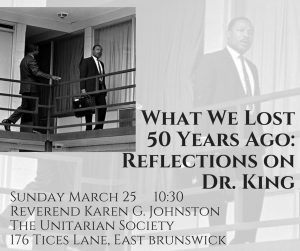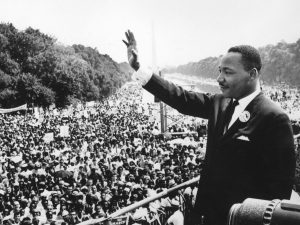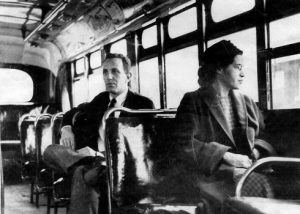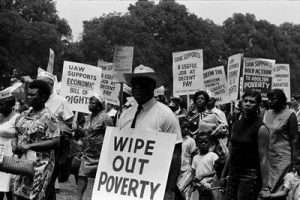
(A heads up: last Sunday, when I was not here, I was actually attending the 9am service at First Baptist of Lincoln Gardens, in Somerset. If you are not familiar with First Baptist, it is a Black Baptist church with at least 5,000 members. The worship and theology there are, shall I say, a little bit different than here. I attended as the guest of a new acquaintance. Nearly an hour had already gone by when the pastor warned us all that he was just about to start the sermon and that it was going to take 35 minutes. Now, this sermon is not going to be 35 minutes. But I am giving you a heads up that I think it’s going to be a bit longer than usual…)
 We all are familiar with the “I Have a Dream Speech.”
We all are familiar with the “I Have a Dream Speech.”
For many of us, perhaps most of us, it can still make your spine tingle. Dr. King’s oratory was fierce and moving, his vision: powerful. When he said – “I have a dream that my four little children will one day live in a nation where they will not be judged by the color of their skin, but by the content of their character.” – it seemed actually possible.

He spoke those words after Rosa sat down so that Martin could stand up with the Montgomery Bus Boycott.
But that speech was before the Voting Rights Act of 1964 – its promise and its limitations — and the Noble Peace Prize of that same year, and Bloody Sunday on the Edmund Pettus Bridge in Selma. It was before John Kennedy was shot, before Malcolm was shot, and most certainly before Bobby Kennedy was shot, because he was killed after an assassin’s bullet killed Martin at the Lorraine Motel in Memphis, Tennessee.
That “I Have a Dream” speech was well before Dr. King joined his voice to those speaking against the war in Viet Nam. That he did a year before he died – actually, exactly a year: April 4, 1967, at the National Cathedral in Washington, DC. He had quietly stated his opposition to the war before then, but on that day, in front of the media, in this very public setting, he formally broke from the policies of President Johnson, a strategy that many in the civil rights movement thought foolhardy.

And it was way before Dr. King, in organizing the Poor People’s Campaign, spoke out in new ways, before he began to sound more like slain Malcolm or a representative of the newly emerging Black Panther movement, just a month before he was killed. In his speech to Union 1199 in New York City, a speech called, “The Other America,” Dr. King moved ever deeper into a radical analysis – radical, meaning getting at the root of a thing – of the causes of racial oppression, examining and identifying the interconnected means of oppression: racial, economic, and imperialistic.
~~~
On April 4, just ten days from now, we mark fifty years since Dr. King was murdered. Next Sunday is Easter, which does not seem like the right time to speak to this uneasy anniversary. And the following Sunday, April 8, I will be at the Revolutionary Love conference, where many of the people carrying on Dr. King’s radical legacy that justice is what love looks like in public, including Reverend Dr. William Barber and Reverend Dr. Liz Theoharis, co-coveners of a resurrection of the Poor People’s Campaign. Yes, that crushed legacy of Dr. King’s is being brought back to life, nationally, as well as in over 30 states, including here in New Jersey, with a planned forty days of action between Mother’s Day (May 13) and June 21, culminating in a rally to launch a multi-year campaign of massive non-violence to address economic poverty with a morally-centered agenda.
So today, we’re looking at Dr. King’s legacy, or lost legacy. Not the palpable legacy that has put Dr. King on a pedestal. Not the legacy that moves the King Estate to sell rights to his “I Have a Dream” speech to sell Ram pick-up trucks on Superbowl Sunday. Not the legacy that has made Dr. King into a milquetoast saint, allowing our revisionist histories of him, his vision, and our relationship with both.

(But maybe, just maybe, it’s the “I Have a Dream” legacy that his granddaughter, Yolanda Renee King, 9-year-old granddaughter spoke about at yesterday’s March 4 Our Lives in Washington, D.C. where she said, in response to gun violence in our nation, that her dream was “enough is enough.”)
When I mention our revisionist tendencies, I’m talking about how in 1999, the Gallup Poll calculated a list of people most admired at that time by the American people. Dr. King was #2 (after Mother Teresa). The funny thing – not funny-haha, but funny ironic – was that in the years leading up to his death, thirty years before he came in at #2, Dr. King rarely appeared on their list of top ten most admired people. In fact, using their scientific means to measure such things, in 1965, the year after he received the Nobel Prize for Peace, it was 45% for both negative and positive regard. And in 1966 – the last year Gallup measured in this way – Dr. King was seen positively by 32% of those polled… and 63% saw him negatively.
It makes me think of the reading in the back of our grey hymnal, #565, from Clinton Lee Scott:
Grandchildren of those who stoned the prophet sometimes gather up the stone to build the prophet’s monument.
On March 10, about a month before Dr. King was murdered, he gave that speech I just mentioned, “The Other America.” In it are three areas of concern that are foundation to the systemic oppression Dr. King was beginning to name as he expanded the civil rights movement to one of human rights. These concerns are the basis of systemic inequity that Dr. King was trying to address through The Poor People’s Campaign, which is what he was focused on when he was murdered.
I am going to read some of Dr. King’s words from that speech fifty years ago; Kathy is going to offer current information on each of the areas of concern that Dr. King raises.
Dr. King: “There are literally two Americas. … I’m sure that each of us is painfully aware of the fact that there is another America and that other America has a daily ugliness about it that transforms the buoyancy of Hope into the fatigue of despair. In that other America, millions of people find themselves forced to live in inadequate substandard and often dilapidated housing conditions. And these conditions: they don’t have wall-to-wall carpets but all too often they find themselves living with wall-to-wall rats and roaches.”
According to the National Low Income Housing Coalition in their 2017 report, a New Jersey resident working a minimum wage job would have to work 106 hours EACH WEEK to afford a modest one bedroom rental at fair market rent.
“In New Jersey, the Fair Market Rent for a two-bedroom apartment is $1,420. In order to afford this level of rent and utilities — without paying more than 30% of income on housing — a household must earn $4,734 monthly or $56,810 annually. Assuming a 40-hour work week, 52 weeks per year, this level of income translates into an hourly Housing Wage of $27.31.”
The most expensive areas: Middlesex, Somerset, and Hunterdon Counties, where the necessary “hourly housing wage” (definition: what it takes to afford a two-bedroom fair market rental) increases to $31.81.
Dr. King “In this other America, thousands – yay even millions — of young people are forced to attend and adequate substandard inferior quality less schools. and year after year thousands of young people in this other America finish our high schools reading at an eighth- and a ninth-grade level sometimes.
Not because they are dumb. Not because they don’t have innate intelligence. But because the schools are so inadequate, so overcrowded, so devoid of quality, so segregated — if you will — that the best in these minds can never come out.”
[The UCLA Civil Rights Project report, published last September] shows that New Jersey has moved another substantial step toward a segregated future with no racial majority but severe racial stratification and division. The resulting harms affect a continually growing sector of the population and mean that schools are not serving their historical function of bringing newcomers and excluded groups into the mainstream of the society.
Although the state has invested billions in trying to equalize school funding under a remarkable series of orders from the NJ Supreme Court, profound racial, ethnic, and socioeconomic gaps remain in educational outcomes. School segregation in NJ is not only by race, but it is double segregation by race and poverty with black and Latino students in schools with far poorer classmates—conditions research shows to be linked to educational inequality. There have been no significant efforts to change these patterns.
Dr. King: “The most critical problem in the other America is the economic problem. By the millions, people in the other America find themselves perishing on a lonely island of poverty in the midst of a vast ocean of material prosperity. … Now what we’ve got to do is to attack the problem of poverty and really mobilize the forces of our country to have an all-out war against poverty because what we have now is not even a good skirmish against poverty.
I need not remind you that poverty — the gaps in our society, the gulfs between inordinate superfluous wealth and abject deadening poverty have brought about a great deal of Despair, a great deal of tension, a great deal of bitterness.”
From an article on NJ.com, written by Carla Astudillo:
“The rich keep getting richer in New Jersey and the poor aren’t keeping pace, new data shows. Income inequality in New Jersey, or the gap between the rich and poor, now ranks 12th-highest in the nation, according to the latest 2012-2016 Census data. It’s getting worse in 14 of the 21 counties, with the other seven remaining steady. The gap is most pronounced in Essex County. Home to both Millburn, which has one of the state’s highest median household incomes at $190,625, and Newark, which has one of the state’s lowest at $33,025, Essex is one of the most economically segregated places in the country.”
It is hard to see much, if any, progress in the past half century since Dr. King’s death. Some progress in some areas, perhaps for a small slice of Black and Brown communities, but little or no movement, perhaps even movement backwards in other areas. I think to how the pervasive presence of gun culture – gun chaos, really — in communities of all shades and socio-economic statuses, has worsened most every ill in our society. It leaves a person feeling despondent, as Dr. King himself would speak to in some of his speeches, including in this speech about The Other America.
~~~
Perhaps this is where music – yes — and gathering together in community – such as happened across our nation yesterday with the March 4 Our Lives, which USA Today said was the largest single-day protest in our nation’s history (with an estimated 800,000 in attendance in DC – the first Women’s March, to compare it to, had 500,000). Perhaps these things can enter in and save us not from such a harsh reality, but from despondency in the face of that reality, so that we might change that harsh reality, so that we might bend that moral arc of the universe towards (what?) ___________________ (justice).
We are blessed and honored to have with us today Terri Lynne Goines, one of Nick’s students from Rider University, who has shared with us the gift of her voice. I knew when I began planning today’s service to honor the anniversary of this infamous deed in American history, that I would want for us to be able to sing what has been called and claimed as the National Black Anthem.
I am also very aware that for a congregation whose membership consists of some, but only a few, people who can claim this song as part of their cultural heritage, that it is important that we be thoughtful and intentional.
I knew the origin story of Lift Every Voice and Sing, but I didn’t know how it came to be part of our Unitarian Universalist hymnody. I learned that from a colleague, the UU minister Joanne Giannino. In a sermon she wrote, she asked the following questions:
Does it make sense for congregations made up mostly of people from the dominant culture to sing African American spirituals? … have they earned the right?
Does it make sense for people who have no lived experience of racism to sing songs that tell a story that isn’t their own? … As new voices try to learn something they can’t quite know but might access through the song, a story, an image, will that matter?
Perhaps singing songs together, and doing so from a variety of traditions, helps us to know one another, help us to recognize and honor each other, helps us to respect boundaries at the right times, to transcend them when that serves a greater good. Perhaps like James Weldon, who was so moved by the experience of turning his spoken word into song, even as the words to that very song recalled a brutal past (a brutality that did not stay only in the past but continued, continues, in the now), that we, too can be moved by the fires of commitment, to “sing a song full of the faith that the dark past has taught us, the hope that the present has brought us.”
For this song with gravitas and history, we come close to earning the privilege of its gift as part of our worship when we seek its story and context, when we give its history the respect it is due. As I thought about how to do this, I knew it would be wrong to just sing this song, so I knew that we would need to learn the history. Also, it did not seem right, given that we are a majority white congregation, for a white person to sing it. And because this is worship – not performance – it seemed wrong just to invite Terrie here to sing for us while we only passively received the song.
So on this day when we honor the vision and legacy of Dr. King, raising up that radical aspect of his vision so often erased, it is that we sing, lifting our voices to the chorus, a hundred years plus in the continual making, of voices singing together. Please rise in body or spirit, as we all sing together the National Black Anthem, our hearts and minds commemorating the tragic day nearly fifty years ago, when this nation and this world lost a voice for justice, peace, and true human decency.
https://www.youtube.com/watch?v=ya7Bn7kPkLo
REFERENCES
http://news.gallup.com/poll/20920/martin-luther-king-jr-revered-more-after-death-than-before.aspx
http://time.com/5099513/martin-luther-king-day-myths/
http://www.nj.com/education/2017/05/diversity_dilemma_why_njs_specialized_public_high.html
http://www.beaconbroadside.com/broadside/2018/03/martin-luther-king-jrs-the-other-america-still-radical-50-years-later.html